Joshua Warren's Blog - Posts Tagged "the-starseed"
The Locations that Inspired The Starseed (Part 1)
If you have already read my sci-fi mystery novel; The Starseed, you might have wondered which of the many locations described in the book are real and which are not. You might have Googled a few, or you might even have already been familiar with some of them, but if I have done my work well then there will also have been a certain ambiguity about at least some of the places visited by Professor Korrigan during his three-day journey through the west coast of Norway.
It is no coincidence that I chose the west coast as the setting for my first novel set in the real world, as I myself grew up in this part of the country—granted a few decades after the book’s setting of 1975. By the time I came into the world in the early 90s the “oil adventure” was already starting to wind down, though it was still very much an unavoidable part of the culture. And my hometown of Stavanger was, and still is in some ways, seen as the “oil capital” of Norway. With these influences I suppose it was only a matter of time before it made its way into my writings.
So, as you can imagine, every single location described in the novel, whether real or made up, will have some connection to actual places that have some meaning to me. Listed here—in order of appearance in the novel—is every town, village and vehicle with a short breakdown of their real-life counterparts.
Mild spoiler warnings for the plot of The Starseed.Just in case you haven’t read the novel yet, I have made sure to avoid any major character or plot-driven spoilers in this article, however, the locations themselves, especially the later ones in part two, can be considered plot spoilers in and of themselves.
In my hometown of Stavanger, just a few kilometres uphill from the inlet where Harald Fairhair united the tribes of Norway into a single nation after the battle of Hafrsfjord in 872 AD, a trio of carefully reconstructed iron age longhouses lie in the shadows of three brutalist apartment blocks from the mid-1970s.
Having been history buff and an armchair archaeologist my entire life it goes without saying that I have visited the Iron Age Farm at Ullandhaug many times over the years, and the odd contrasts of this location has never ceased to amuse me. The illusion of having travelled back to the age of the Vikings would have been perfect had it not been for the three apartment buildings that always seem to intrude upon the scene whenever you try to take a nice picture of the place. And if you try to take a picture southward, with the mountains of the Bokna Fjord clearly visible on the horizon, you will also get a nice panoramic view of the University in Stavanger, not to mention the peculiar-looking old telecommunications tower that stands atop a forested hill nearby.
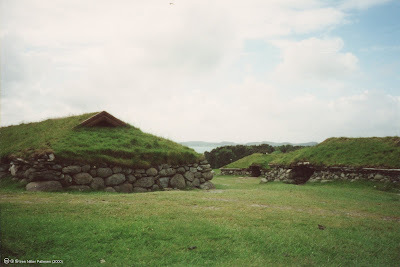 One of the few “clean” views of The Iron Age Farm at Ullandhaug back in 2000 before the construction of the visitor centre.
One of the few “clean” views of The Iron Age Farm at Ullandhaug back in 2000 before the construction of the visitor centre.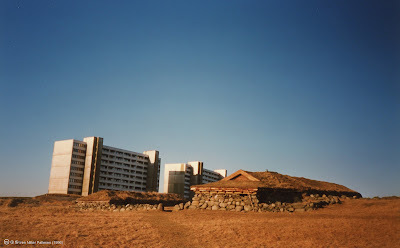 Stone and concrete. These brutalist apartment buildings were raised in mid-1975, the same year as the Iron Age Farm reconstruction was completed. Photo taken in Feb. 1996.
Stone and concrete. These brutalist apartment buildings were raised in mid-1975, the same year as the Iron Age Farm reconstruction was completed. Photo taken in Feb. 1996.
Ullandhaug, much like the plot of The Starseed, is a fascinating tapestry of the old and the new placed side-by-side. It therefore seemed appropriate to start my story in a location inspired by Ullandhaug. Likewise, what better way to introduce an archaeologist than having him partake in an archaeological dig.
Although I’m a sucker for pulpy adventures about daring explorers discovering ancient temples in the jungles of India or in the Egyptian desert, Korrigan is not Indiana Jones, so for this story I wanted to depict a realistic archaeological excavation that allowed me to incorporate the changeling myth that is central to the novel. The slow and laborious process of an excavation is admittedly not the most exciting thing to read about, but I knew it would serve as a good introduction to my characters and themes, and since ancient Norway was once littered with homesteads like the one at Ullandhaug, I figured a near-identical one could be buried under the fields of some farm in the nearby county of Suldal. As a matter of fact, while in the late stages of writing the novel, I found out that archaeologists had recently performed a series of lidar sweeps over Ritland in Suldal proving the presence of multiple prehistoric settlements. I could make some joke about having a sixth sense for archaeology, but you could dig in almost any field near the south-west coast and find signs of ancient habitation. Case in point, one of the most important archaeological digs in Stavanger (the excavation of the so-called “Gausel Queen” from 1997-1999) was a mere fifteen-minute walk away from where I grew up. I remember my mother taking me to watch the archaeologists work when I was seven years old. Clearly it must have had a strong effect on me.
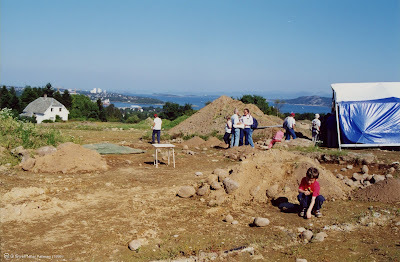 The excavation of Dronningåsen ("The Queen's Hill") in September 1999. The kid in the red T-shirt is me.
The excavation of Dronningåsen ("The Queen's Hill") in September 1999. The kid in the red T-shirt is me.A few years later as part of a field trip during my short tenure as a Boy Scout I spent a whole day, and night, at the iron age farm at Ullandhaug. This was many years before the construction of the nice visitor centre that now stands at the foot of the hill, so we slept in sleeping bags placed atop sheepskin covered wooden benches, and the closest thing we had to a bathroom was a small, smelly outhouse with a door that didn’t close.
Almost two decades later I returned to the Iron Age Farm, not as a history enthusiast, but as a filmmaker, and used one of the longhouses as a shooting location for my 2022 Fantasy short film; The Wild Huntsman. If you’re curious, you can watch the whole 5 min. short here.
 Shooting a scene with actor Vegard Heggelund at the Iron Age Farm during the summer of 2021. Photo by Kornelius Kiil Enoksen.
Shooting a scene with actor Vegard Heggelund at the Iron Age Farm during the summer of 2021. Photo by Kornelius Kiil Enoksen.
The inclusion of the Tau ferry docks, though very brief, actually carries a bit of significance for a local like myself, doubly so as someone who quite enjoys the whole atmosphere of ferry rides, something which is sadly becoming less common nowadays. Up until the completion of the Ryfast subsea tunnel system in 2019, the only two ways to get to Tau (and Suldal) from the Stavanger peninsula was either to drive around the whole arm of the Bokna fjord, or to take the Tau-Stavanger ferry. Since Tau is the largest settlement near Pulpit Rock (if you’re not already familiar with it, you might have seen Tom Cruise climb it during the climax of Mission Impossible: Fallout) it was the most natural place for tourists and locals alike to travel through, that is, until the tunnel was built.
The tunnel is naturally faster and more convenient, but in my opinion, a poor substitute for the charm of taking the ferry across the fjord on a sunny summer day on your way to hike up to one of Norway’s most iconic locations. Although I grew up in the suburbs of Stavanger on the opposite side of the fjord, I somehow never got around to visiting Pulpit Rock until I was in my early twenties, when I did the hike with a good American friend of mine that was visiting in 2014. Judging from his holiday photos from his visit I’d venture a guess that he would agree with my assessment that the ferry was an integral part of the charm of the whole trip. A few years later he visited Norway again, this time bringing along his wife (he’d gotten married since his last visit), and although we chose another, even more scenic route this time, we still had to take a ferry. The third time I went to pulpit rock, this time with my brother (his first time) and an American relative (it was a first for him too) we naturally took the Tau-Stavanger ferry. This was in 2018, one year before the completion of the tunnel, and therefore my last trip with the ferry.
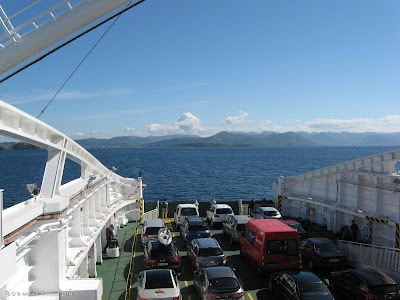 I couldn't find any photos of the Tau ferry docks, so here's the ferry on its way there in 2014.
I couldn't find any photos of the Tau ferry docks, so here's the ferry on its way there in 2014.STAVANGER
When I first started working on The Starseed I decided that I wouldn’t dwell too much on the city of Stavanger despite it being my hometown and chose instead to make it part of Professor Korrigan’s journey from the excavation to the drill rig. After all, if you wanted to fly out to any form of petroleum industry-related rig in 1975 it would have to be through Stavanger. However, I couldn’t ignore the city of my upbringing entirely, so what started as a few simple sentences evolved into a brief tour of downtown Stavanger, appropriately seen through a historical lens.
The route that Korrigan takes in the book, starting at Østervåg, then following through Vågen and finally into the town square, is for all intents and purposes one of necessity and historical accuracy, and yet it very much is a perfect summary of the history of the city. I did in no way exaggerate when I described it as a thousand years of history crammed into less than a minute of driving.
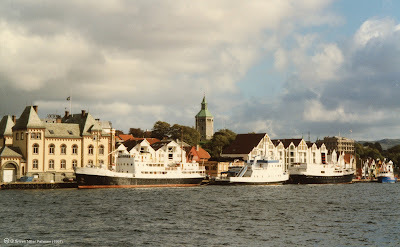 Vågen bay, Stavanger, in 1997, though it appears much the same today and would not have changed much since the novel’s setting of 1975 either.
Vågen bay, Stavanger, in 1997, though it appears much the same today and would not have changed much since the novel’s setting of 1975 either.
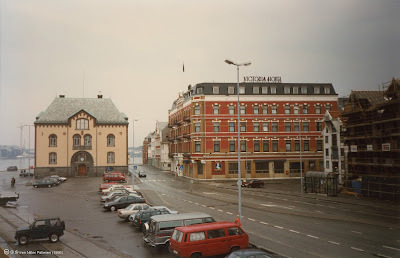 Toldboden (left) and Victoria Hotel (right) on a grey April morning in 1996, not too different from how Korrigan would have seen them in March of 1975.
Toldboden (left) and Victoria Hotel (right) on a grey April morning in 1996, not too different from how Korrigan would have seen them in March of 1975.
Even today, if you stand at the end of the bay at Vågen and you look out towards the fjord you are likely to see some pretty large signs of industry as you’ll be facing the Rosenberg shipyard. And although you are not likely to see any oil rigs under construction anymore, you are still likely to spot some kind of tanker or cargo ship not unlike the ones observed by Korrigan on his ferry ride into the city. Turn around and look in any direction and you’ll see plenty of signs of Stavanger’s maritime history, from the traditional porthouses now turned into bars and nightclubs to your left, and to your right, towering above most other buildings you’ll find the modernist Ankerbygget (literal translation: “The Anchor Building”). Look closely and you’ll find anchors incorporated not only into the wrought iron balconies but also in the granite façade itself. Stavanger is not only a thousand years of visible history in one place, but a living tribute to all things maritime.
But on the opposite side of the town square, slightly to the left of the Stavanger Cathedral School, you’ll see a grey granite cathedral that has looked very much the same as it has done for the past 900 years; Domkirken.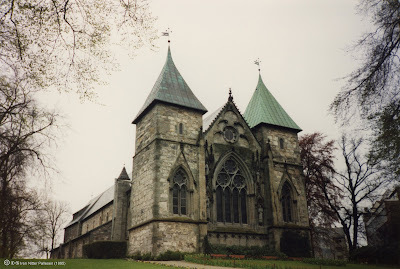 The Stavanger Cathedral in 1995 before the recent renovation work done in preparation for its 900th anniversary in 2025. This shows the more extravagant rear view as opposed to the simpler, more mediaeval-looking front end that Korrigan would have seen.
The Stavanger Cathedral in 1995 before the recent renovation work done in preparation for its 900th anniversary in 2025. This shows the more extravagant rear view as opposed to the simpler, more mediaeval-looking front end that Korrigan would have seen.Stavanger Cathedral—colloquially known as Domkirken—is the oldest cathedral that’s been in continuous use in Norway and was finished around 1150, though the city counts the year 1125 as its official foundation. Some experts maintain that part of the structure could date back as far as 1090, with others claiming that an old wooden church could have stood on the site for several centuries prior. The elaborate gothic façade on the east end (pictured above) was constructed in the late 13th century after the city had been ravaged by a fire in 1272. The western façade with the main entrance, which is the side that Korrigan would have glimpsed during his brief drive through downtown Stavanger, has a much more modest and mediaeval look to it.
Although the nave has always been open to the public (with certain exceptions), I have been fortunate to get to visit some of the less commonly seen parts of the cathedral over the years, such as the crypt and even the bell tower. In preparations for the city and the cathedral’s joint 900th anniversary in 2025, the church has been undergoing extensive renovations and has been entirely closed off since 2020. Unfortunate news for tourists, but it has been a golden opportunity for local archeologists who have used the restoration process as an excuse to excavate in places that have previously been completely out of limits.FORUS AIRPORT
The location of the partially abandoned runway described in the third chapter is pretty much “down the road” from where I grew up, though by my time there was little to suggest it had once been an airstrip. As a kid me and my friends would often cross this location as a shortcut to the mall. We’d go down the hill, through the tunnel under the E39, and then step through a hole in a fence that took us to a large empty square of asphalt that I was always told used to be a landing platform for helicopters. At the time I didn’t think much of it, my mind was usually focused on the contents of the toy store or the pet shop (I had a friend who collected stick insects) hidden behind the row of office buildings and workshops on the other side of the empty lot.
As I describe in the novel, this simple airstrip was built by the Deutsche Luftwaffe in 1941 at the start of the German occupation of Norway. After the war it was supposed to be used by the Norwegian military, but little ever came out of it, presumably due to the much larger airport in Sola which is a short drive away. During the late 60s the airstrip was finally put to use by Helikopter Service as a means to ferry workers out to numerous oil rigs that were popping up all over the North Sea. The airstrip was used as a helicopter base until 1989 when a new and improved helicopter terminal was opened at Sola airport. Since the helicopters had no need of the full length of the three taxiways, it was not uncommon for the locals to use the empty stretches of tarmac to help their teenage children practise for their driver’s licence. In fact, my mother learned to drive there in the late 70s.
Researching this familiar, but once very different locale for the book, was at once fascinating and somewhat difficult as there are very few photos of the place during the 70s. Small patches of the old taxiway can still be found here and there, having been converted into parking lots or integrated with new roads, and from what I’ve read online one of the maintenance hangars still exists.
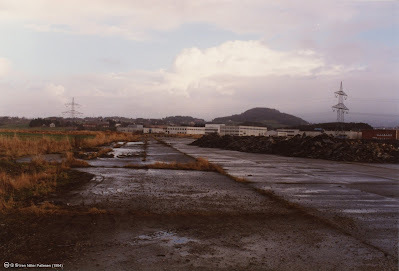 What was left of the airstrip in 1994, photographed by my mother. Although this predates it by a couple of years, I spent most of my childhood living at the foot of the hill you can see in the far background.
What was left of the airstrip in 1994, photographed by my mother. Although this predates it by a couple of years, I spent most of my childhood living at the foot of the hill you can see in the far background.SOLA AVIATION MUSEUM
Although a very minor influence on the actual story, and despite Sola airport only being mentioned in passing in the book, I would still feel remiss if I did not mention the Aviation Museum at Sola.
This is very much the kind of old-fashioned, no-nonsense museum that I sorely miss these days and that seemed to be the norm when I was a child. It is the very definition of utilitarian and is completely devoid of the pretentious art-gallery vibe that is so common in modern museums. What you see is what you get, and the locale itself is as much a piece of history as the exhibitions within.
 The museum was founded in 1984 and is run by local volunteers. Photo taken July 2023.
The museum was founded in 1984 and is run by local volunteers. Photo taken July 2023.The museum itself is an old WWII aircraft hangar stuffed with all kinds of aircraft, ranging from something as small and simple as a former civilian owned Bell 47 single-rotor, single-engine light helicopter, to a duo of American jet fighters from the 50s such as the Republic F-84G Thunderjet and the RF-84F Thunderflash. They have various German Luftwaffe aircraft such as a Messerschmitt Bf 109, as well as the only remaining airframe of an Arado 196 which was stationed on the Kriegsmarine cruiser ship the Blücher, which was sunk in the Oslofjord in April 1940. As if such an assortment of fighter jets, both partial and complete, were not impressive enough, standing dead-smack in the centre of the hangar is a full-on Douglas DC-6 airliner with a capacity of up to 70 passengers. And as if one full airliner wasn’t enough, standing beside it is a slightly smaller, but still massive, Convair CV-440 Metropolitan once used by SAS and Norfly. But the most impressive plane in the collection by far (or at least in my opinion), has to be their beautifully restored, black-painted Consolidated PBY-5A Catalina amphibious aircraft from the 1930s. Although not the largest plane in the hangar, and by no means the most spacious one within, there is just something raw and menacing about the massive silhouette of this beast of a flying boat, aided in no small part by its pair of massive three-bladed propellers attached to the 32 metre (104 ft) wings raised above the fuselage like some massive predatory bird about to take flight. I am also a sucker for all things 1930s and 40s, and the domed gun turrets give it that vintage charm that in my opinion has never been surpassed.
However, at the end of the day, I came for a single purpose—one perhaps a tad mundane compared to all that I’ve described so far, and that was to get a good look at the museum’s Bell UH-1 Iroquois (or “Huey”) helicopter, as I know a few of them would be an important part of the eventual discovery of the stolen LNG tanker ship in the novel. Compared to the MD 500 (“flying egg”) used by Marshall, the UH-1 does play a fairly small part in the plot, but since the museum didn’t have an MD 500, I had to consult online sources in that case. I did likewise for the UH-1, of course, but when there was one sitting in an aircraft hangar less than an hour away from where I live, I figured it was as good an excuse as any to go and visit a museum I had not been to since I was a kid. Besides, the trip did prove useful to my research after all, and the information accompanying the helicopter did clarify a question I had about where the Norwegian Air Force's Hueys would have been stationed in 1975. Getting to inspect one in person also gave me a good indication of just how many people could realistically be crammed into a single helicopter, making me realise that the passenger capacities I had read online were quite ambitious.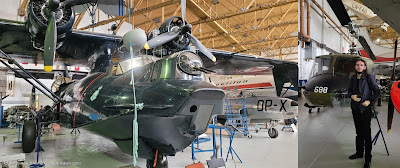 Left: A Consolidated PBY-5A Catalina from 1932. Right: Bell UH-1 ("Huey") helicopter formerly owned by the Royal Norwegian Air Force. Photos taken July 2023.
Left: A Consolidated PBY-5A Catalina from 1932. Right: Bell UH-1 ("Huey") helicopter formerly owned by the Royal Norwegian Air Force. Photos taken July 2023.
THE NORWEGIAN PETROLEUM MUSEUM
Although I grew up surrounded by people working in the petroleum industry—heck the headquarters for Statoil was right down the road—I’ve never actually been to a rig of any kind. It’s not exactly like you can just pop down to the nearest oil rig and ask if you can have a look around. I have, however, been to the next best thing; The Norwegian Petroleum Museum.
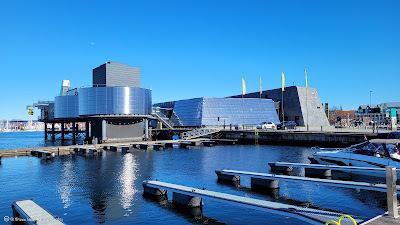 Photo taken in 2023 showing the back-view of the museum with the mini ‘oil rig’ protruding from the main building on the left.
Photo taken in 2023 showing the back-view of the museum with the mini ‘oil rig’ protruding from the main building on the left.Opened in 1999, the petroleum museum, much like the Iron Age Farm, is one of those places I’ve continually visited since I was a kid, either through school or on my own accord, though admittedly, I never all that much attention to the historical or technical nuances of the exhibits until I got the idea to set my first Korrigan novel in Norway during the oil rush in the 1970s.
The one part of the museum that has always stood out to me, is the large back-section that emulates an oil rig. At first you step into a fake plane, complete with sound effects and TV screens in the windows, and then you step onto a walkway that takes you out of the museum and onto the “rig,” complete with crane, emergency raft, a genuine control module filled with retro-looking buttons and levers, a more modern control chair that looks like something out of a sci-fi movie, and even an escape chute for the kids to try out. Although the “effects” used to immerse you in this experience were, and still are, somewhat crude, it was still very much an experience that left a big impression on me as a child.
 A 7-year-old me on the mini-rig on opening day, May 20th, 1999. The Rosenberg shipyard can be seen in the background. I still have the ticket stub from that day. The text reads: The Norwegian Petroleum adventure began when this drill bit struck oil in 1969. The rest is history.”
A 7-year-old me on the mini-rig on opening day, May 20th, 1999. The Rosenberg shipyard can be seen in the background. I still have the ticket stub from that day. The text reads: The Norwegian Petroleum adventure began when this drill bit struck oil in 1969. The rest is history.”CONTINUED IN PART 2.
THE STARSEED: A Professor Korrigan Mystery
One night in February of 1975, a group of young men and women broke into a random house on the west-coast of Norway and abducted an infant child. A note with a pagan symbol used in ancient magic rituals was left in the crib. It was the first of several clues to the terrible secret of THE STARSEED.
Genre
: Paranormal Mystery.
Setting
: Norway, 1975.
Date of publication
: December 17, 2023
The Starseed is the first book in a planned series following the paranormal adventures of the English archaeologist, Professor Mortimer Korrigan.
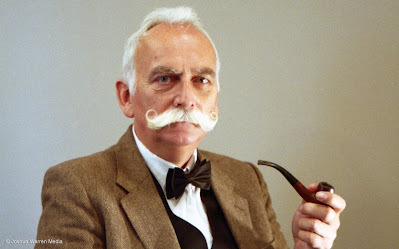 Professor Mortimer Korrigan is an accomplished, if not slightly infamous, archaeologist. Though a prolific researcher and excavator, his successes are often overshadowed by his failures—failures that often garner much publicity due to the eccentric claims that often preceded them. Little does the general public know just how right he really is. (Photo model: Arne Vagle.)
Professor Mortimer Korrigan is an accomplished, if not slightly infamous, archaeologist. Though a prolific researcher and excavator, his successes are often overshadowed by his failures—failures that often garner much publicity due to the eccentric claims that often preceded them. Little does the general public know just how right he really is. (Photo model: Arne Vagle.)
HOW THIS NOVEL CAME TO BE
As a fan of both Mysteries and Horror it was only a matter of time before I dipped my toes into both genres. And while I enjoy a good straight forward murder mystery, it is not a genre I was interested in writing myself, that is, without adding some “fantasy gimmick” to make it more me (note that I use fantasy in the broader sense of the word here, as in fantastical, not in the orcs and dragons sense). My solution then was to make a paranormal mystery in the tradition of the old “occult detective” genre, albeit with my own modern-ish spin to it.
While I am by no means a believer in the paranormal (though I do try to keep an open mind), I have always been fascinated by TV shows like Kolchak: The Night Stalker and The X-Files, the latter of which always managed to bring a strong sense of realism to stories that dealt with extraordinary threats like aliens and ghosts and other things that go bump in the night. What could have easily turned into a simple monster-hunter series managed to tell very human stories that more often than not dealt with very real issues. I’ve always liked that approach to fiction, where the extraordinary represents some facet of humanity, or if not, it does at the very least provide a narrative opportunity for the characters to respond to it in ways that say a lot about who they are, or even who we all are as a species.
It is no wonder then that I immediately become a huge admirer of Nigel Kneale, the writer of such classic BBC series as Quatermass and the Pit, whom I first discovered while putting the finishing touches on my first novel; Dawn of the Karabu. Stripped of any gimmicks, Kneale’s paranormal stories were really about the world around him, often tackling serious issues like class differences, authoritarianism, and racial tensions. And while I personally don’t hold any disdain for escapist fiction the way that Kneale often did, I do feel that so-called ‘genre fiction’ like Science-fiction and Horror are at their best when dealing with real issues in this manner and it is a philosophy that I very much aspire to emulate in my own work.
 André Morell as rocket scientist Bernard Quatermass in the 1958 miniseries 'Quatermass and the Pit.'
André Morell as rocket scientist Bernard Quatermass in the 1958 miniseries 'Quatermass and the Pit.' Copyright © BBC.
The resulting idea that came from all of this, however, was not The Starseed. I initially started working on a novel called The Highland Incident, a kind of ‘old dark house’ style story set primarily in a Scottish abbey, though now that I had begun developing what I intended to be a recurring character, it was hard not to start looking ahead and start planning what his other adventures would be. This wasn’t just me getting caught up in the world-building, but also a bit of a necessity as the middle-aged Professor Korrigan would from the beginning be established as someone who had already gone through several adventures. It was during this process that I started toying with the idea of a story set in my own home region in the south-west coast of Norway, and keeping in mind that I wanted my stories to have some form of historical and cultural relevance it only made sense to focus on the oil rush that started in the late 1960s and was still very much alive when I was growing up in the city of Stavanger (one of several real locations visited in the book). Of course, this immediately meant that the story would have to take place after the events of The Highland Incident, which takes place in 1967, as the “Norwegian Oil Adventure” didn’t truly begin before 1969. It seemed like the beginning of a good idea, and I quickly decided it would make for a good short story that I could hopefully get published somewhere as a little teaser for my upcoming Korrigan novel. Needless to say, it didn’t quite turn out that way.
What started as a simple short story quickly escalated into a novella, which in turn evolved into a full novel (albeit a fairly short one). Clearly, I had taken my intent to make a human story out of something extraordinary to heart, as it was the story of the misguided eco-terrorists that eventually tipped a simple narrative about a strange meteorite and a kidnapping into a larger and much more morally complex story told from two different points-of-view. Suffice it to say, without going into spoiler territory, that the kidnappers played a much simpler and more traditionally villainous role in my first draft, something that simply didn’t sit right with me.
The end result is, I hope you’ll agree, a much more complex story that accurately reflects a lot of the philosophical and political tensions of the time—and perhaps even today.
The Locations that Inspired The Starseed (Part 2)
This is the second part of my breakdown of the real-life locations that inspired Professor Korrigan's three-day adventure through the Norwegian west-coast in my novel; The Starseed.
If you haven't already read Part 1 you can do so here.
Mild spoiler warnings for the plot of The Starseed.Just in case you haven’t read the novel yet, I have made sure to avoid any major character or plot-driven spoilers in this article, however, the locations themselves, especially the later ones featured here, can be considered plot spoilers in and of themselves.
The small fishing village of Lunvik that I introduce about halfway through the story is the only settlement in the novel that is entirely fictitious, though naturally inspired by real locations. The village is in many ways an amalgamation of several villages that I have visited, but the one place that I drew the most inspiration from—though I only realised this after the fact—was the small port town called Skudeneshavn.
The name Skudeneshavn is quite fascinating, and is a combination of three words. The first part comes from the Old Norse; Skúta, which literally means “protruding rocks” and refers to the rocky skerries that line the shore around the southern end of the island. Nes and havn, two words that are still in use in modern Norwegian, translates to “headland” and “port.” Due to the archaic nature of the first third of the name, with skude being very similar to modern word skute, I was always under the misconception that it referred to the “ships” that would enter the port at the headland. Ask most Norwegians what the name means and they’ll likely give you the same answer.
As the actual name suggests, it is a very old port town. It lies at the very tip of the large island county of Karmøy, where, a bit further north, you’ll find the historically important site of Avaldnes (more on this later).
 Skudeneshavn in 2016.The one thing that separates Skudeneshavn from the fictional village of Lunvik, however, is its complete lack of mountains. Although mountains were never far away during my upbringing—in fact the backdrop of the nearest grocery store was a mountain range on the opposite side of the Bokna fjord—the landscape where none-the-less relatively flat, consisting mostly of rolling hills and the occasional bump in the landscape that neither qualifies as hill nor mountain. I actually grew up at the foot of one of these bumps, or nut (pronounced “noot”) as they’re called in Norway, a word with no direct English translation. So, I was thankfully spared having to cycle down mountain roads like the two unfortunate boys at the start of the chapter I somewhat dramatically titled Draugen. My great-great-great grandfather on the other hand, did grow up in a place not too dissimilar.
Skudeneshavn in 2016.The one thing that separates Skudeneshavn from the fictional village of Lunvik, however, is its complete lack of mountains. Although mountains were never far away during my upbringing—in fact the backdrop of the nearest grocery store was a mountain range on the opposite side of the Bokna fjord—the landscape where none-the-less relatively flat, consisting mostly of rolling hills and the occasional bump in the landscape that neither qualifies as hill nor mountain. I actually grew up at the foot of one of these bumps, or nut (pronounced “noot”) as they’re called in Norway, a word with no direct English translation. So, I was thankfully spared having to cycle down mountain roads like the two unfortunate boys at the start of the chapter I somewhat dramatically titled Draugen. My great-great-great grandfather on the other hand, did grow up in a place not too dissimilar.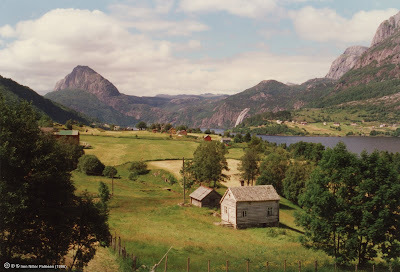 Farmland near the village of Dale photographed by my mother in July 1996.
Farmland near the village of Dale photographed by my mother in July 1996.In the village of Dale (the name literally translates to “valley”) you are quite literally flanked by mountains on all sides, with your only means of exit or entry being a slim, winding road through the mountains, or by water through one of the many veins of the Sunnfjord. Unlike the comparatively large town of Skudeneshavn, this is the type of village that has a single grocery store and a “shopping centre” consisting of four stores, and that’s including the aforementioned grocery store. And in this way, I suppose Dale is actually a much closer approximation to the fictional Lunvik, if only in size rather than its overall aesthetic. Since Dale lies far within the Sunnfjord, unlike Lunvik which lies by the coast at the mouth of a fjord, it is not a port town, but rather a community that once made its living from factories, exporting mainly shoes and barrels.
As I alluded to before, part of my family comes from this village; specifically the Nitter branch on my grandmother’s side. The Nitters were quite well-off and there were quite a few fascinating characters living in Dale in the 19th century, though the one that I have always heard a lot about—thanks in large part to him having kept a very detailed diary—was Adolph Nitter, my great-great-great grandfather. Well educated and well read, Adolph’s writings were both eloquent and insightful, providing a fascinating glimpse into life in Europe two centuries ago. Since he came from an affluent family, and since he was groomed to take over his uncle’s trade, he was able to travel abroad in a way that few others were able to in his days.
His father (i.e. my great-great-great-great grandfather) was a lensmann, which, as I also described in the novel itself, means that he was the police chief. They even had a little cell for prisoners in the house itself. But it was Adolph’s son; Einar, who eventually left Dale behind, moved to Stavanger, and the rest is history.
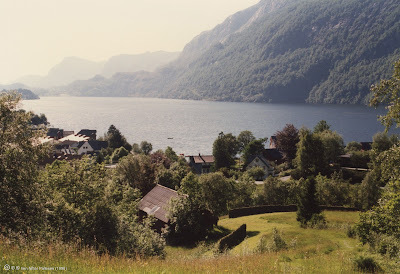 The village of Dale seen from the old Nitter house atop the hill. Photo taken in July 1996.
The village of Dale seen from the old Nitter house atop the hill. Photo taken in July 1996.
The reading room of the University of Bergen Library that I describe at the midpoint of the novel is the only location that isn’t based on any place that I have actually been to, be it directly or indirectly. Granted, I have been to many libraries throughout my life, as well as a few archives, so I suppose you could categorise this location as being based on an educated guess rather than anything related to personal experience. Of course, the library itself does exist, but although I have visited the city of Bergen several times I’ve never had any reason to visit it. I originally had Korrigan visit the Bergen Public Library, a very striking-looking neo-Romanesque building that I have passed by on many occasions due to it being located right next to the railway station, but decided that the university library made much more sense for an academic. The public library does, despite its somewhat mundane name, house many old books in their archives, though largely related to local history. Not quite fitting for the esoteric Icelandic compendium that Korrigan reads through in the novel.
Of course, Korrigan visits more than just the library in Bergen, though I can thankfully say that I have never needed to visit the police station.
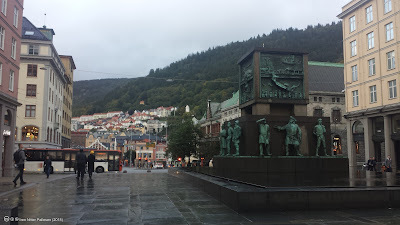 The main square in downtown Bergen on a rainy August day in 2018.
The main square in downtown Bergen on a rainy August day in 2018.The hotel that I usually stay in when visiting the city was not converted to a hotel until the late 90s, and was as such of no use to me while writing about Korrigan’s brief overnight stay in 1975.
After researching the history of well-established hotels in Bergen—a task that proved far more complex than I had imagined it would be—I finally concluded that the Hordaheimen Hotel would suit my purposes for the story. Although I have never been to this hotel, and I could easily have just made up a name for it seeing as not much happens at this location other than Korrigan finally getting a relatively good night's sleep, it did prove to be something of a fascinating rabbit hole. Not only did the hotel once house a famous (and quite huge) painting of St. Olav Haraldsson (King of Norway from 1015 to 1028) by Nils Bergslien (1853-1928) in the dining room, but it has also a fascinating connection to one of the most well-known unsolved crimes in Norwegian history; the so-called “Isdal Woman.” In November 1970 an unidentified woman was found dead in Isdalen (“The Ice Valley”) near the city. The last time she was seen alive she had checked out of Room 407 at the Hordaheimen hotel where she had stayed under one of what later turned out to be several false identities. It is generally believed that she was a spy, though I’m not going to delve into all the details of this case here. But if you're fascinated by real-life cold war mysteries, then this one is definitely worth your time.
Lastly, I’d like to point out that contrary to my somewhat gloomy description of the city in the novel, I do actually think Bergen is a really nice place. So, in order to make up for it, here’s a nice sunny photo to give you a more cheerful impression.
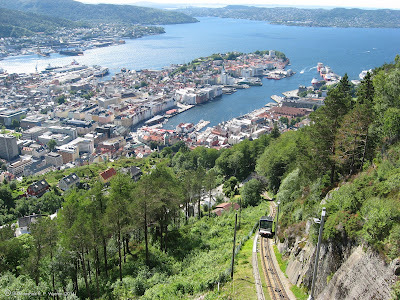 Photo taken in 2014 from the viewing platform atop Fløyfjellet which can be easily accessed via the Fløybanen funicular railway with the lower terminus down in the city.
Photo taken in 2014 from the viewing platform atop Fløyfjellet which can be easily accessed via the Fløybanen funicular railway with the lower terminus down in the city.
STOPLESTEINAN
You might have thought that the stone circle Korrigan finds hidden within the small patch of trees at the terminus of the Heimrinn fjord had to be a purely fictitious place, but when Hagen casually stated that there must be thousands of stone circles all around the country it was no exaggeration. Norway really is littered with standing stones to the point where most of them remain largely ignored by all but the most committed history buffs. It is not uncommon to still find lone marker stones in the middle of some field with no sign or trail to indicate that there is anything of historical value. Of course, they are protected by the state, but unless there is something particularly unusual about them, or if there’s more than one, then there is rarely any effort made to make them easily accessible—something which I have experienced on more than one occasion.
One unusual collection of standing stones that do have both signs and a path to follow, though only barely, are Stoplesteinan in Egersund.
Egersund is a port town a little less than an hour by train south of Stavanger (and about 30 minutes from where I live now). It is a city I am quite familiar with for multiple reasons, the first being that my late grandfather had a summer house on an island close to the city, and the second being that it is something of a local tradition to visit the city during the Christmas season as Egersund is famous for “Julebyen,” an elaborate Christmas market that have been held there every year for as long as I can remember. However, I have never ventured past the city centre, and in order to access Stoplesteinan you have to walk through the city, into the suburbs, and up a very steep hill that at first seems to lead you right up into someone’s driveway—which you do—until you spot a tiny bridge—a plank of wood really—over a small stream that leads to a downtrodden path. As is quite typical with Norwegian forest trails, apart from a few rudimentary means to help you cross the occasional stream and fence, there is not much to go by other than a simple trail. And when I say trail, I mean a trail in the true sense. I’m not talking about a gravel road, I mean a thin, irregular line of downtrodden grass that indicates that at least some other human beings have walked there before. Eventually you make your way up to the top of a plateau nestled in between two “bumps” in the landscape and there you will find a circle of 16 stones. The tallest ones are roughly waist-high compared to your average adult male. There are no visible carvings of any kinds on these stones, and their original purpose can only be guessed at.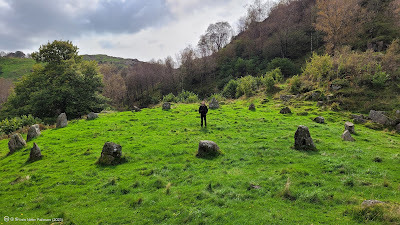 Standing at the centre of Stoplesteinan in 2023.
Standing at the centre of Stoplesteinan in 2023.It’s a peculiar little site really. When standing at the centre of the stone circle, in all directions but west (where the suburbs are quite visible in the gap between the two “bumps”) you can hardly see any signs of civilisation apart from the occasional power lines on the far horizon. It is almost like you have stepped back in time to the ancient past and you begin to wonder what the purpose of this place originally was. Even though Google Maps reveal that the stones are nestled in between the Egersund suburbs and a cluster of farms, it is still very much on the edge of the modern world. To the east lies nothing but 250 km (150 miles) of mountainous wilderness that stretches all the way to the east coast. Even in the 21st century, much like in the Viking age, people generally live along the coast and the centre of the bulbous shaped bottom half of the country is—apart from the occasional rarely traversed road—the same today as it would have been a thousand years ago, or ten thousand years for that matter.
At this point in the text, I would normally have included a translation of the name of this place, but I must confess that I haven’t the faintest idea what a stople is supposed to be, and all my attempts at Googling it haven't turned up any satisfactory answers either. What I can say, however, and without having to look up any Norse translations, is that “steinan” simply means “stones,” so there’s that.
And finally, I’d also like to point out that I visited Stoplesteinan quite far into the process of writing The Starseed, so I can’t truly claim this to be the primary source of inspiration of the mysterious magnetic stone circle described in the novel, rather I visited it for the purpose of photographing it for my book trailer. If you haven’t already seen it, you can do so here.THE LNG TANKER SHIP AT AVALDSNES
You never know when inspiration will hit you, and hit me it did during a visit to Avaldsnes on the island of Karmøy some two-hours by bus and ferry north of Stavanger. Avaldsnes is in many ways the birthplace of Professor Korrigan, as it was there I got the inspiration for both The Starseed and the upcoming follow-up novel; The Highland Incident. I will detail the origins of the latter story some other time, but it was during a visit in 2021 that I spotted something odd that once more spurred on my imagination.
For those who are interested in history there are three main attractions to visit at Karmøy; St. Olav's Church at Avaldsnes, the Nordvegen History Centre right “next door” to the church, and The Viking Farm on Bukkøya—a recreated Viking age village not too dissimilar to The Iron Age Farm in Stavanger. After having paid a visit to the church and the museum during the summer of 2021 I stopped in the cafeteria for a lunch break and looked out a window over the grassy hills that lead to Bukkøya, where the Viking village lies hidden within a forest. My eyes swept the rocky hills and I spotted the occasional sheep munching on the grass before coming to a stop at the channel of ocean water that separates Karmøy from the city of Haugesund on the mainland, and there I saw a large anchored tanker ship. As someone who grew up in a port town with strong ties to the oil industry, I thought little of it other than noting the somewhat unusual look of the bulbous gas tanks and continued with my lunch.
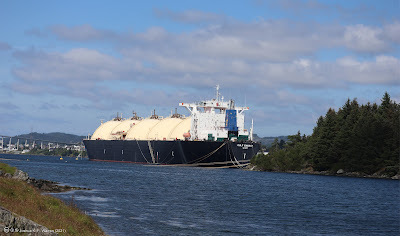 The LNG tanker ‘Gulf Energy’ was, according to a marine traffic website I found, built in 1978 and is currently (as of 2024) not in service. Photo taken in 2021.
The LNG tanker ‘Gulf Energy’ was, according to a marine traffic website I found, built in 1978 and is currently (as of 2024) not in service. Photo taken in 2021.Once I finished my lunch I left the museum and started the short trek over to the Viking village. I casually noted that the tanker was still there, but my mind was more focused on all things Vikings since this was less than a month after the shoot of my fantasy short film in Stavanger. A little over an hour later, once I had seen everything the Viking village had to offer, I crossed this open patch of land once more and again the tanker was just sitting there on the water. Now it drew my full attention, and I found myself attaching my zoom lens to my camera and I began taking pictures of it. Although I could see the city in the distance, the tanker was mostly framed against forested hills in addition to being partially covered by the northern tip of Bukkøya, creating a strange contrast of nature and modern engineering. In my mind I began erasing the city in the distance, I removed the nearby houses, the bridge, and I imagined it all alone, surrounded only by nature. There were no people onboard that I could see, even with my zoom lens. Why was it there? Who had brought it here? What was hiding within its steel hull? For whatever reason I imagined that there was some kind of alien hidden within, and thus the first seed of an idea for a novel had been planted in my head.
Mysterious tanker ships aside, Avaldsnes is a very fascinating place and one of the most historically rich places in all of Norway. It served as the capital of Norway during the Viking age and was the seat of power for the aforementioned king Harald Fairhair who united all of Norway at the battle of Hafrsfjord just downhill from the Iron Age Farm at Ullandhaug. And as I alluded to before, my next Korrigan novel; The Highland Incident, has its roots in an apocalyptic legend connected to the church that rests atop the hill looking down at the strange ghost ship resting in the Karmsund strait.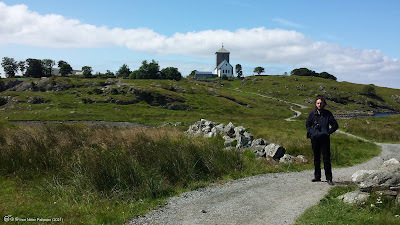 The church at Avaldsnes in 2021. The small building just to the left of the church was a temporary structure built around an archaeological excavation. The museum can be seen between the trees on the far left.
The church at Avaldsnes in 2021. The small building just to the left of the church was a temporary structure built around an archaeological excavation. The museum can be seen between the trees on the far left.A special thanks to my mother for letting me scour through her photo albums for a lot of these pictures, and for helping me find some that I didn’t even know existed.
Making the Book Trailer for The Starseed
NOTE: This article references the full-length book trailer for The Starseed in a way that assumes you are already familiar with it. If you have not seen it, or if you'd like to re-familiarise yourself with the video, you can do so by clicking HERE.
INTRODUCTION
My biggest passion as a creative person has always been filmmaking. Although I did write fiction as a child, I was not much of an avid reader until later, and once I started making amateur films with my friends at age 12 it quickly became apparent to me that I wanted to be a filmmaker.
Of course, filmmaking, even in its simplest form is still an expensive and labour-intensive process requiring a fair amount of people, and the fact that I’m drawn towards sci-fi, fantasy and historical fiction hasn’t exactly made things easier.
In this case literature has been a real blessing for me. Granted, making a novel isn’t exactly free, especially if you want it to be up to professional standards. Though in the case of The Starseed I managed to save some money by designing the cover myself—one of the many benefits of a Media & Communications education. But,compared to a making a film, writing a novel is about as financially freeing as it can be, and you are only limited by your imagination. There are no actors’ fees, no location permits, no props, no sets. If you can write it, the audience can (hopefully) imagine it.
Of course, a book still requires some marketing if you want people to become aware of it. So, I decided to put some of my filmmaking skills to good use and make a book trailer. Most trailers that are out there, even the “professional” ones, are in my opinion, quite lacklustre, often relying on bland stock footage. I wanted to make something that would stand out.
THE CONCEPTI was still working the novel when I started work on the trailer (final rewrites, spell checks, fact checks, that sort of thing), and not wanting to distract myself too much from finishing the very thing I was going to market, I decided to avoid anything that could accidentally turn it into an expensive short film. I therefore decided to make the video entirely out of still images, something which also had the added benefit of making it unlikely that it would be mistaken for a trailer for an actual film. Stills of real people and locations would provide me with a certain degree of authenticity, but it would be different enough to not give a false impression of the “product” I was advertising.
Naturally, as often is the case with any creative process, I started with many different ideas, some good, some bad, not to mention some very ambitious, until out of discipline and, unfortunately, in some cases, out of plain bad luck, I eventually managed to whittle it all down to something simple and surmountable.
GOING ANALOGUEI have always been a sucker for the analogue aesthetic. Digital technology has served me well in the past (and still do), and I would not have been able to do most of my short film work without it, but there is simply something special about celluloid film. I have been fortunate enough to have shot one of my short films at the London Film Academy on super 16mm film, and I very much hope to one day be able to upgrade to full 35mm film as I genuinely see it as the superior medium for filmmaking. There is simply a richness to the colours, a depth in the collection of silver crystals, a sharpness of the interplay between light and shadow that simply cannot be fully emulated digitally. Of course, digital video has reached a level of quality that makes it a more than worthy alternative, though I am adamant that it is not a substitute.
However, for this book trailer 35mm film provided me with several benefits, and in this case it did admittedly have very little to do with image quality. Here it was simply a case of instant authenticity. I have several SLR cameras, all of which belonged to my mother, ranging from the simple to the complex. For practical reasons I went with complex and chose to use two Canon SLR cameras from the late 80s. Not entirely authentic to 1975, but I did not want to risk anything going wrong with the “cheaper” cameras from the 70s. I knew I would have to be economic with my 35mmfilm, though my initial, and frankly naïve, assumption that I could pull off the entire trailer with just one roll of film quickly escalated to four.
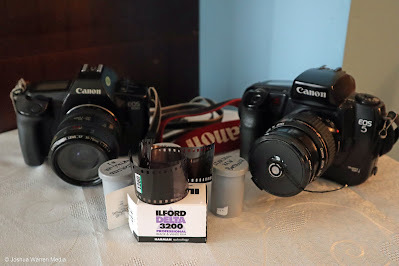 My Canon EOS 650 & Canon EOS 5 cameras.
My Canon EOS 650 & Canon EOS 5 cameras.
FINDING PROFESSOR KORRIGAN
I had originally planned to find local actors, models, or just anyone who was willing to be photographed, to portray allof my main characters, not just Professor Korrigan, but Marshall, Hagen, and even Bergström as well. Suffice it to say that this didn’t work out, so I was forced to simplify things to just Korrigan.
That solved three problems, but still left me with the most important one, and a big one at that; where do I find someone in the Stavanger region that looks like an English professor with an Imperial moustache? I actually considered buying, or even commissioning, a fake moustache at some point, but I was sure that I had seen someone with an appropriate moustache locally. But where? And when? I searched and I searched, and at one point, through a friend who knows a lot of interesting people, I seemed to have found a near-perfect match; a true anglophile who could provide me with not only the moustache, but tweeds, hats, pipes, the whole works. Unfortunately, he had just taken ill and declined my offer. After more futile searching I decided to call someone I knew personally. He was a far cry from the dandy Englishman I pictured in my head, but he did have a moustache that was close-enough, and being a local actor who worked for a revue he could provide me with his own costumes. I asked him and he was willing to take sometime off to pose for me. I counted my blessings. At that point I considered this a huge victory in a project that had been nothing but setbacks and compromises.
Though I was, and still am, extremely grateful for his willingness to support this project, I must admit that the end result was such a far cry from what I had imagined while writing the book that I somewhat despondently carried on with the project worrying that the first official depiction of my new recurring character would be so unfaithful to the book—and done by myself no less! Shortly after, however, my salvation finally came in the form of a poster.
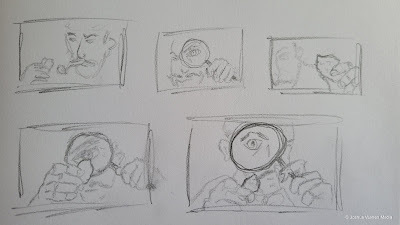 Some crude "storyboard" sketches for the Professor Korrigan photoshoot.
Some crude "storyboard" sketches for the Professor Korrigan photoshoot.Every year, in the town of Bryne where I live, they have a festival called Potetfestivalen (literally translated as “The Potato Festival”). And at the very top of the posters littered all over the town to inform of the upcoming activities was a photo of a man that immediately made me think; “that’s Korrigan!” Granted, an English gentleman like Korrigan would never be caught dead wearing a plaid shirt and a baseball cap with a picture of an anthropomorphised potato on it, but the slim face, the hawk-like nose, the dark-grey hair, and of course, the moustache, was perfect. With some help from the people running the festival I managed to track down the man on the poster, contacted him, and was thrilled to hear that he was willing to be the face of Professor Korrigan.
His name is Arne Vagle. He is a specialist in grains and potatoes working for the Norwegian Agricultural Advisory Service in Rogaland, and once I had learned of who he was, it quickly dawned on me that I had seen him many times before and that he was most definitely the moustached local man that I previously alluded to. It turns out that Vagle has been present at every Potato Festival since its creation in 1998, where he always presents a colourful assortment of different kinds of potatoes. Although I am admittedly not much of a connoisseur of potatoes, I had definitely seen him at the festival before and had clearly made some mental note of his distinguishable stache that had partially reemerged at the start of this project.
I met Vagle at his office and decorated one of the walls there with a cheap green tarp I had bought the day before to imply that he was sitting within a tent as a part of the archaeological excavation described in the book’s first chapter. After I had snapped a series of photographs here, I asked him if there was a basement or something to that effect that could be used to represent the machine room of the LNG tanker from the opposite end of the book, and he took me down to a locker room with a large metal cabinet and some air vents that that made for a passable backdrop. These photos, taken more-or-less in the dark, came out a little fuzzy, but that only enhanced the moody and grimy look that I wanted.
 Two unused photos of Arne Vagle in costume.
Two unused photos of Arne Vagle in costume.There’s not too much to say about the costume Vagle wore. The tweed jacket I found at a 2nd hand store, and the rest was common enough. The pipe and the potsherd on the other hand are both very special and carry a bit of personal history.
The pipe belonged to my great grandfather and has been in the possession of my mother ever since he passed away in the1970s. In fact, he had several pipes, two classic bent apple ones, a steel tipped jet pipe, and a foldable vest-pocket one for travel. I chose one of the two classical ones, favouring the one with the most noticeable signs of use as it seemed the most suitable for my well-travelled professor.
The piece being examined by Korrigan is part of a collection of real Native American potsherds found in the Arizona desert by my mother in the early 90’s shortly before I was born. Most of these sherds, which have always been on display in my mother’s living room for as long as I can remember, wouldn’t pass for Viking-era pottery, so I chose one of the most neutral ones. My mother, like myself, has always been quite fascinated by history and archaeology, so when I showed her the original photos I took she quickly reminded me that an expert on ancient pottery would focus on the cross-section of the rim in order to determine the overall shape and size, and thereby also the style and era, of the original pot. So, when I later handed the piece to Vagle, I made sure to relay this information to him.
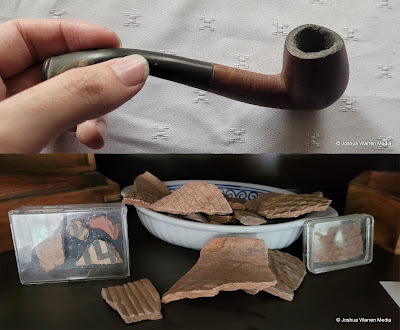 My great-grandfather's pipe and my mother's collection of Native American potsherds.
My great-grandfather's pipe and my mother's collection of Native American potsherds.BUILDING A CRIB ON A BUDGET
I knew early on that the ominous note left behind in the crib by the eco-terrorists would be an important visual motif in the trailer, so it was clear from the beginning that I would have to recreate the photo that Special Agent Marshall hands Professor Korrigan during their first meeting at the start of the book.
The note itself wasn’t a problem, and my mother provided me with the little teddy bear you can see in the top left corner. But what about the crib itself? I didn’t want to spend time and money buying a whole crib, let alone a vintage one, just for a single photo. The answer was a clever no-budget solution I had picked up at the London Film Academy. For a scene set in a prison cell, the director of photography had the clever idea to create the illusion of a barred window by stretching some black electrical tape over an empty frame that we held up to the light, thereby casting long vertical shadows over the actors. For the trailer photo I simply put a bedsheet over a rectangular foam pad, placed the note, the teddy bear, and a blanket that my mother had kept since I was a baby on top of it, then held a metal frame with a few rows of black tape in front of the window on a bright autumn day and snapped my photo.
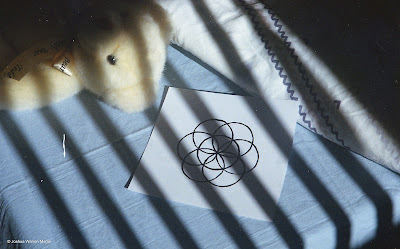 Rejected photo where the illusion of a crib doesn't quite work.
Rejected photo where the illusion of a crib doesn't quite work.AN AMERICAN CAR IN NORWAY
I also wanted to actually show the arrival of Marshall at the excavation, the latter of which I knew would have to be represented with a simple stock image which I eventually acquired through the archive at the University in Stavanger. As for the agent himself, since my original plan to include several actors/models never panned out, I decided instead to emphasise the mystery of the situation and figured that his foot stepping out of the car would suffice. The foot, if you were wondering, is mine.
But what of the car? I had a foot (and oneto spare), I had some reasonably appropriate footwear, and I could easily find a rural spot to shoot the scene in (there’s plenty of those in Jæren), but you might think that vintage American cars aren't exactly something that everyone has in their garage. Lucky for me, however, I live in the Norwegian countryside, a place practicality riddled with American car enthusiasts. The largest organised group is called Amcar (quite simply short for “American car”). I contacted the local branch and gave a general sense of the type of car I was looking, deciding that this was not a time to be picky about exact models.
I eventually met up with Terje Tytland, the owner of a beautiful1970 Ford Lincoln Continental. Though fairly different from the Chrysler described in the book, it did have that elongated and blocky silhouette that just screamed early 70s. If Marshall hadn’t gone for the Dodge Polara, this might have been his second choice. So, on an appropriately overcast day we took the car out to a country road where I snapped a few pictures of the car and he snapped a few of me stepping out of it.
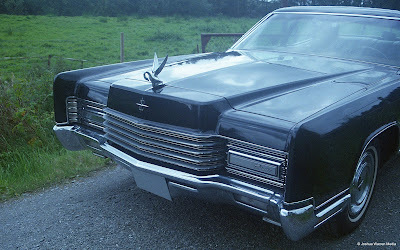 A closer shot of the Ford Lincoln Continental that was not used in the trailer.
A closer shot of the Ford Lincoln Continental that was not used in the trailer.OILY GEODES
The meteorite shown in the trailer was another lucky no-budget solution. In 2008, while visiting some friends in the US, we went geode hunting in a stream in Illinois. During the drive we were given a rundown of what we might find—our “guides” had done this sort of thing many times before and had practically become experts—and explained that there were supposedly some geodes that contained raw oil, though they had never seen this. We hiked down to the stream, found several stones of varying sizes, cracked a few open, but one proved particularly tough, so we brought it back to our friends’ house and later that evening we took turns trying to break it open. The hammer passed from person to person, sparks literally flew from the rock as the hammer hit it, and eventually, as if it finally yielded to our curiosity, it neatly divided into two almost equally sized halves and a glob of black liquid splotched onto the pavement. It was actually filled with oil! You can still see dried up oil in the cracks of the odd, almost organic-looking interior of this strange geode, and we were told that the larger oil stain remained visible on the pavement for the better part of a year after we’d left.
Although the coarse, grey surface of this river rock is technically another incongruity with the novel, where it’s described as a smooth obsidian-like stone, it did fit most people’s preconception of what a meteorite should look like, and with its weird-looking interior revealed in cross-section, I decided to once again not squander a good opportunity with nitpicking.
The basement of my mother’s workplace just so happened to still have a bunch of furniture and random bits of equipment from the 70s and 80s scattered about, and provided a perfect backdrop for the scene where Bergström, also played by me, sneaks into the geology lab of the drill rig and places the stone on the table. Likewise, the rusty metal floor seen in the background when the stone is picked up (this time by my mother) was simply a small landing between two stairs near a restaurant a few blocks away from where I live that I felt had a nice industrial look to it. Yet another simple no-budget solution.
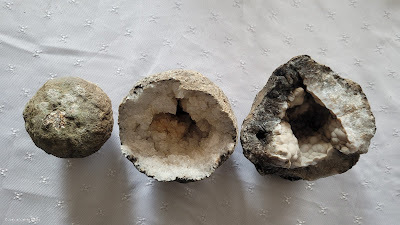 A normal river stone, a common geode, and a not so common geode. The black marks on the geode on the right are what's left of the crude oil.
A normal river stone, a common geode, and a not so common geode. The black marks on the geode on the right are what's left of the crude oil.THE CHILD
The last image seen in the trailer was actually one of the first things I photographed.
The solution was quite simple, though I must say, quite absurd looking in person. I purchased a baby doll from a 2ndhand store, got some black fishing line from a sports store, and I simply hung the doll from some air vents in the parking garage of the apartment building where I live. I suspended some black blankets with some old clothes hangers (and some tape) around one entrance to this little shortcut passage between two sections of the garage in order to block out the light from one side and to make sure that the bright light from the other would make the doll just a silhouette.
The end result was…reasonable. It was certainly strange.
But with some photoshopping it not only ended up looking quite retro, but had that surreal, X-Files inspired look that I was going for. In hindsight, though, there was so little left of the original aesthetic that I doubt if the B&W film made much of a difference.
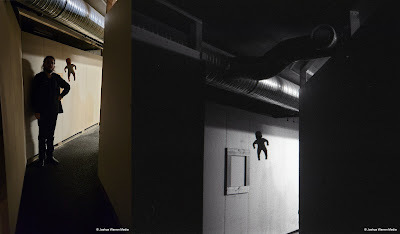 Left: Probably on of the oddest BTS photos that has been taken of me. Right: The original B&W photo before it was photoshopped beyond recognition.
Left: Probably on of the oddest BTS photos that has been taken of me. Right: The original B&W photo before it was photoshopped beyond recognition.ODDS AND ENDS
Finally, just to be thorough, and in casesome of you were wondering, here’s a brief explanation of the remaining photos that, in my opinion, didn’t have enough of a story behind them to warrant giving them their own section.
The house and the stairs representing the home of the kidnapped child were two separate locations, with the latter belonging to an artist friend of mine who not only lived in a house from the70s but who collects all things odd and retro, such as the radio and the old Dole cardboard box that you can see at the bottom and top of the stairs. The house seen from the outside belongs to some old friends of my mother.
The stone circle is an actual pre-historic stone circle in Egersund which I have already written about in detail in my article about the Locations that Inspired The Starseed.
The two photos of the Aker H3 drill rig, and of the petroleum workers within, are historical stock photos generously provided by Norsk Oljemuseum (The Norwegian Petroleum Museum).
And finally, though I did both the photo and the video editing myself, the rest of the post-production phase was largely done through people I know via The London Film Academy (the sound editing was done in Norway by Bibow Audio, who worked on both of my 2022 short films). The music was composed by Isabel Woodings, who was recommended to my by the co-producer and 2nd unit director of my short film Paradox, Oscar Hewitt, who on this project was also responsible for the voice-over recording.
The narration was done by voice actor David Mander, whom I discovered through an online casting process. The recording took place at the London Film Academy with Hewitt organising what can best be described as "long-distance-directing," meaning I directed the whole affair via Google Meet while Hewitt and Mander were together in the studio in London. Contrary to much of the analogue process used in the making of this trailer, this final step was a very modern solution that worked surprisingly well.
How Retired Policemen helped me Research The Starseed
I've previously written about some of the unique challenges that arises when writing about an archeologist, not only for the obvious reason that I am not one myself (though the subject has fascinated me greatly since I was a child), but also how I have had to force myself to focus my research primarily on "outdated" knowledge as any modern information found online would not be relevant when writing about a mid-20th century academic like Professor Korrigan. I wrote about this in another article titled My "Outdated Archaeology Library.
However, since The Starseed is primarily a crime story with elements of archaeology sprinkled in throughout, I was faced with the additional challenge of having to get into the specifics of Norwegian law enforcement in the mid-1970s, something which would never have been possible if not for a handful of people associated with The National Museum of Justice and The Norwegian Police History Society. In this article I would like to add additional thanks to these individuals while also explaining in further detail than what I did in the book's short acknowledgments section on how exactly they helped make my novel as authentic as it is.
 The main entrance to the National Museum of Justice in Trondheim, Norway.
The main entrance to the National Museum of Justice in Trondheim, Norway. Wikimedia Commons photo by Wolfmann.
When I first started work on The Starseed I did what most people do when researching any given subject nowadays, I used Google. However, I quickly found that this was quite limiting. I have often found that the internet is rarely the best source of information regarding esoteric subjects, especially here in Norway. Now, if I'd have to solve similar issues related to law enforcement in say, the US or the UK, then it would likely have been a completely different story. The problem with Norway, however, is not so much that the information doesn't exist, but rather that there aren't enough people to allow the information to trickle on to the internet. The population is simply too small. In America, at least when compared to Scandinavia, there is simply no such thing as a niche. Even the smallest and most esoteric of niches, even if the percentage of the population remains as low as in Norway, you're still likely to find thousands, if not tens of thousands, or even hundreds of thousands of people within said niche. America does have a population of over 300 million people after all. Norway in comparison has only 5.
So, when the internet failed me it became clear that I'd have to go directly to the source of the information that I wanted—which is a lot more fun anyhow. But where to start?
 The extensive digital archives on digitaltmuseum.no proved an invaluable source during the writing process.
The extensive digital archives on digitaltmuseum.no proved an invaluable source during the writing process.
Now I must point out that I did have some luck with my online research, mostly thanks to the digital archives at digitaltmuseum.no where I found several photos of items belonging to the police from the middle of the 20th century. However, the labels weren't always too specific on precisely when these items had been used. They preferred to give very broad and general periods of use, usually measured in decades. I did however quickly find that all of them belonged to the same museum, The National Museum of Justice in Trondheim.
Now Trondheim is a fair bit further north in Norway from where I live and at the time going there in person wasn't really an option, but I now had a handful of vaguely labelled photos that I felt gave me a decent sense of what the police men in my current draft would likely have used and decided to contact the museum in the hopes that someone there could help me confirm or correct my assumptions. I've found that it's much smarter to ask for corrections rather than blank-slate questions that effectively boils down to "do the research for me." I quickly got a reply from Hilde Haaverstad Olsø, the collection administrator & conservator and she not only replied to my list of questions, she also forwarded my request to two individuals with direct experience in law enforcement during the period of my book's setting; retired Kripos investigator Oddmund Dahle & retired police superintendent Magnar Skaret.
Dahle was largely responsible for helping me confirm that my depiction of Kripos, both for The Starseed and a brief appearance in another novel I'm working on, was largely accurate. Although this book never goes too deep into Kripos operations, it was important to me that the character of Kripos Investigator Harald Hagen, and his function within the story, was completely in line with the duties and jurisdiction of Kripos back in the 1970s. Early in our correspondence it quickly became apparent that although my depiction of Hagen himself was quite accurate, I had overestimated the full range of Kripos' responsibilities and how they cooperated with other branches of the law. This forced me to make some necessary adjustments to the later chapters in the book where I depicted a police raid on the novel's antagonists, the Environmental Liberation Front (ELF) eco-terrorists. A bit more on this later.
All in all though, it was really interesting to get to exchange emails with an actual former Kripos investigator, something which I had not predicted when I began work on this novel.
Moving on from Kripos, it must be said that it is Magnar Skaret, a retired police superintendent & chief of staff from Trondheim, who deserves the bulk of the praise when it comes to my depiction of the Norwegian police in the The Starseed. Skaret went beyond simply answering the myriad of questions that I kept sending his way, he was also generous enough to send me copies of two books that he'd written for the The Norwegian Police History Society. Actually, calling them books don't do them justice, they are more like tomes.
After having corresponded with Skaret for a while it became clear to him that the information I was after went well beyond general information about police duties, but ventured into very specific esoterica, something which, thankfully, Skaret was very much the right man for. Of course, no one can be expected to remember every little detail about police equipment, uniforms, procedures, etc. so he concluded that the best thing to do would be to send me copies of the two books he had written and published at this point. What I received in the mail about a week later were two massive volumes dense with information on every imaginable detail related to their broad subject matters. I almost feel a little bad for having since left these two books lying on a shelf where they have remained largely untouched as I only needed a tiny fraction of the vast knowledge contained within.
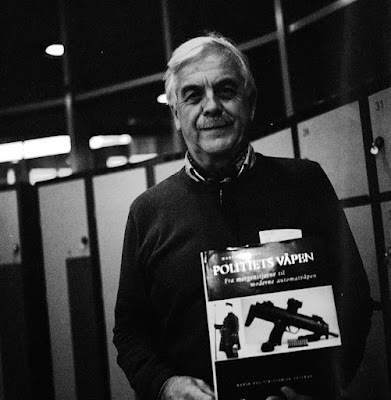 Magnar Skaret with his book on police weapons throughout the years.
Magnar Skaret with his book on police weapons throughout the years. Photo by S. Aarsbog.
Where these books proved the most useful was for the aforementioned raid depicted towards the end of the novel. After having been corrected by Oddmund Dahle that Kripos would not have been directly responsible for such an operation, I had to figure out exactly who would have been the natural choice. Since Skaret had, among his diverse range of duties over the years worked with Beredskapstroppen, AKA Delta Unit, he recommended that I include them in the book. This did pose a bit of a problem as Delta Unit was not made operational until January 11, 1976, about ten months after the setting of my story. Int he end, however, I decided to bend the facts ever-so-slightly in my favour, and included them despite this minor timing anachronism. Yes, there was a somewhat similar unit present before called Østlandstroppen, though I never quite felt that this group had the correct training that was required for my fictional raid. Instead I decided to conjure up a secret early trial run of the unit, something which would have been quite plausible as the suggestion to form Delta Unit had been greenlit by the police in January of that same year.
My depiction of Delta may not be 100% accurate as far as timing is concerned, but their uniforms, equipment, weaponry, and their overall function in the story is completely within the realms of reality had the unit been operational ten months earlier.
Skaret, Magne. 2009. Fra Varde til SMS: Politiets Sambandshistorie. Oslo: Norsk Politihistorisk Selskap. The title roughly translates to "From Cairns to SMS: The History of Police Communications."
Skaret, Magne. 2017. Politiets Våpen: Fra Morgenstjerne til Moderne Automatvåpen. Oslo: Norsk Politihistorisk Selskap. The title roughly translates to "Police Weapons: From morning stars* to automatic rifles."
*In case you were wondering what a morning star is, it refers to several types of club-like weapons consisting of a shaft with a spiked ball attached to the top. These were quite common with the night watchmen ('Vekter' in Norwegian) that up until about 150 years ago patrolled the streets with only said club and a lantern. There's actually a well know statue in my hometown of Stavanger depicting one of these watchmen with a morning star in one hand and a lamp in the other (though the latter, minus the handle, was stolen many years ago). You can see a photo of watchman with a morning star on the cover of the 2nd (green) book below.
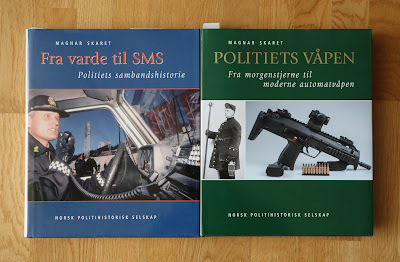 Skaret's tomes on police communications and weaponry.
Skaret's tomes on police communications and weaponry.
I would also like to point out that Skaret recently added a third book to his bibliography, this time focusing on police vehicles titled Til lands og til vans og i luften med Politiets Transportmidler. While I was making the final adjustments on The Starseed and sending my final questions to Skaret (I think it was about Delta Unit communications) he informed me that he just handed in the final draft of this book, at over 600 pages. The book was published a few months later in early 2024 via NPHS.
I would like to once again thank Magnar Skaret, the late Oddmund Dahle (who passed away April 2024), Hilde Haaverstad Olsø, The National Museum of Justice and The Norwegian Police History Society for their help with my research for The Starseed.




